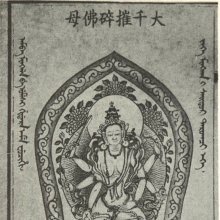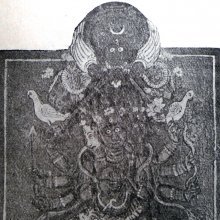Mahasahasrapramardani, Mahāsāhasrapramardanī: 4 definitions
Introduction:
Mahasahasrapramardani means something in Buddhism, Pali, Hinduism, Sanskrit. If you want to know the exact meaning, history, etymology or English translation of this term then check out the descriptions on this page. Add your comment or reference to a book if you want to contribute to this summary article.
Images (photo gallery)
In Buddhism
Tibetan Buddhism (Vajrayana or tantric Buddhism)
Source: archive.org: The Indian Buddhist IconographyMahāsāhasrapramardanī (महासाहस्रप्रमर्दनी) refers to one of the five Protector Goddesses (Rakṣa or Pañcarakṣa), commonly depicted in Buddhist Iconography, and mentioned in the 11th-century Niṣpannayogāvalī of Mahāpaṇḍita Abhayākara.—Her Colour is white; her Symbol is the discus; she has four faces and ten arms.—Mahāsāhasrapramardanī is the second deity in the group of five Rakṣā deities and she is assigned to the eastern direction.
Mahāsāhasrapramardanī is described in Niṣpannayogāvalī as follows:—
“In the East there is Mahasahasrapramardani sitting in the lalita attitude on the orb of the moon placed on a double lotus. She is white in colour, has a halo of the white moon and is four-faced. Her principal face is of white colour, the right blue, the face behind is yellow and the left is of green colour. In her five right hands she shows 1. the eight-spoked wheel on a lotus, 2. the varada-mudrā, 3. the goad, 4. the arrow and 5. the sword. In her five left hands she exhibits 1. the vajra, 2. the raised index finger (tarjanī), 3. the noose 4. the bow and 5. the noose Thus she is ten-armed”
The Sādhanamālā describes Mahāsāhasrapramardanī somewhat differently Here the deity has only eight arms instead of ten.

Tibetan Buddhism includes schools such as Nyingma, Kadampa, Kagyu and Gelug. Their primary canon of literature is divided in two broad categories: The Kangyur, which consists of Buddha’s words, and the Tengyur, which includes commentaries from various sources. Esotericism and tantra techniques (vajrayāna) are collected indepently.
General definition (in Buddhism)
Source: Cambridge Digital Library: Pañcarakṣā, SaptavāraMahāsāhasrapramardanī (महासाहस्रप्रमर्दनी) refers to the third of “five protections” (pañcarākṣa) classified as a dhāraṇī according to a 17th-century Sanskrit manuscript from Nepal .—The earliest evidence for texts grouped together as the “five great dhāraṇīs” comes from Tibetan catalogues around 800 CE. These scriptures include spells, enumerations of benefits and ritual instructions for use.
Languages of India and abroad
Sanskrit dictionary
Source: Cologne Digital Sanskrit Dictionaries: Monier-Williams Sanskrit-English DictionaryMahāsahasrapramardanī (महासहस्रप्रमर्दनी):—[=mahā-sahasra-pramardanī] [from mahāsahasra-pramardana > mahā > mah] f. Name of one of the 5 gr° tutelary goddesses, [Buddhist literature]
[Sanskrit to German]
Mahasahasrapramardani in German
Sanskrit, also spelled संस्कृतम् (saṃskṛtam), is an ancient language of India commonly seen as the grandmother of the Indo-European language family (even English!). Closely allied with Prakrit and Pali, Sanskrit is more exhaustive in both grammar and terms and has the most extensive collection of literature in the world, greatly surpassing its sister-languages Greek and Latin.
See also (Relevant definitions)
Partial matches: Mahasahasra.
Full-text: Pancaraksha, Mahasahasrapramardana, Maharaksha, Pancarakshamandala, Raksha, Sahasra.
Relevant text
Search found 1 books and stories containing Mahasahasrapramardani, Mahāsāhasrapramardanī, Mahāsahasrapramardanī, Mahasahasra-pramardani, Mahāsahasra-pramardanī; (plurals include: Mahasahasrapramardanis, Mahāsāhasrapramardanīs, Mahāsahasrapramardanīs, pramardanis, pramardanīs). You can also click to the full overview containing English textual excerpts. Below are direct links for the most relevant articles:
The Indian Buddhist Iconography (by Benoytosh Bhattachacharyya)
Related products

